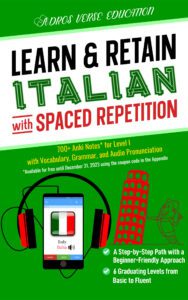1. Abjad Writing System
2. Romanization of the Arabic Abjad
3. Cursive Features of Arabic Letters
4. Vowels in Arabic
5. Stressed Consonants
6. Hamzah
7. Open-T vs. Tied-T
8. Syllable Stress in Arabic
1. The Definite Article الـ (al)
2. Double Vowel Ending – تَـنْويـن (Tanwīn)
3. Gender
4. Personal Pronouns
5. Word Patterns in Arabic
6. Introduction to Grammatical Cases
7. Dual & Plural
1. Sentences
2. Demonstrative Pronouns
3. Phrases
4. Grammatical Cases of Nouns & Adjectives
5. Past Tense
6. Adjectives
7. Cardinal Numbers
1. Present Tense
2. Negation
3. Prepositions
4. Interrogatives
5. Relative Pronouns
6. Conjunctions
7. Active & Passive Participles
8. Ordinal Numbers
1. Giving Commands & The Imperative
2. Irregular Verbs I
3. Verbal Nouns
4. Degrees of Comparison
5. Special-Use Particles, Nouns, & Pronouns
6. Progressive & Perfect Tenses
7. Nouns of Place, Instrument, & Intensity
8. Adverbs
1. Passive Voice
2. Irregular Verbs II
3. Impersonal Verbs & Expressions
4. إِنَّ (’inna), كـانَ (kāna), كـادَ (kāda) & ظَـنَّ (ẓanna)
5. Specification & Disambiguation
6. The Five Nouns
7. Circumstantial Adverb
8. Absolute Object & Causal Object
In Arabic, the حـال (ḥāl) ‘circumstantial adverb’ is an adjective that explains “how” the action of the verb occurs.
Let us look at some examples:
| وَصَـلَ الـرَّجـلُ إِلـى الْـبَـيْـتِ مُـتْـعَـبًـا٠ waṣala -r-rajulu ’ilā -l-bayti mut‘aban. The man arrived home tired. |
| غـادَرْتُ حَـزيـنًـا٠ ghādartu ḥazīnan. I left sad. |
| أَنْـهـى الْـجَـيْـشُ الْـمَـعْـرَكَـةَ مُـنْـتَـصِـرًا٠ ’anhā -l-jayshu -l-ma‘rakata muntaṣiran. The army finished the battle victoriously. |
| غـادَرَتِ الـنِّـساءُ سَـعـيـداتٍ٠ ghādarat (i) -n-nisā’u sa‘īdātin. The women left happy. |
Notice that in the sentences above, the حـال (ḥāl) ‘circumstantial adverb’ is:
- an answer to “how” the action of the verb occurs.
- always in the accusative case.
- never preceded by a definite article or a preposition.
Another way to describe the ‘circumstantial adverb’ in Arabic is by using the conjunction وَ (wa) ‘wāw,’ known as واو الـحـال (wāw al-ḥāl) ‘circumstantial wāw,’ which is followed by a nominal sentence.
| وَصَـلَ الـرَّجـلُ إِلـى الْـبَـيْـتِ وَهُـوَ مُـتْـعَـبٌ٠ waṣala -r-rajulu ’ilā -l-bayti wa-huwa mut‘ab(un). The man arrived home tired. |
| غـادَرْتُ وَأَنـا حَـزيـنٌ٠ ghādartu wa-’anā ḥazīn(un). I left sad. |
| أَنْـهـى الْـجَـيْـشُ الْـمَـعْـرَكَـةَ وَهـوَ مُـنْـتَـصِـرٌ٠ ’anhā -l-jayshu -l-ma‘rakata wa-huwa muntaṣir(un). The army finished the battle victoriously. |
| غـادَرَتِ الـنِّـساءُ وَهُـنَّ سَـعـيـداتٌ٠ ghādarat (i) -n-nisā’u wa-hunna sa‘īdāt(un). The women left happy. |
Notice that in the sentences above, the adjective is in the nominative because it now functions as the خَـبَـر (khabar) ‘predicate’ of the nominal clause.
Next: Absolute Object & Causal Object
Other lessons in Level VI:









